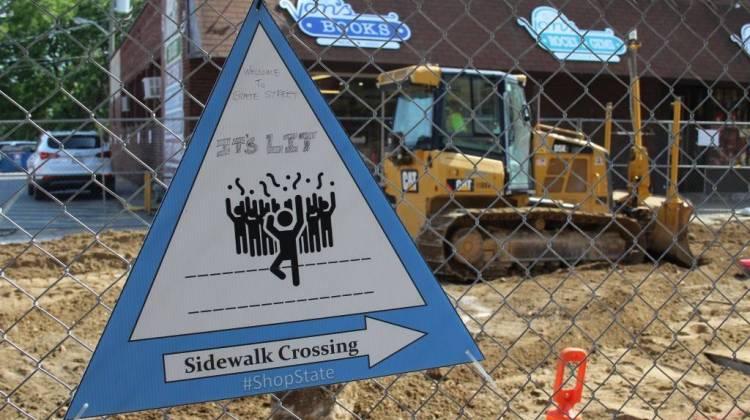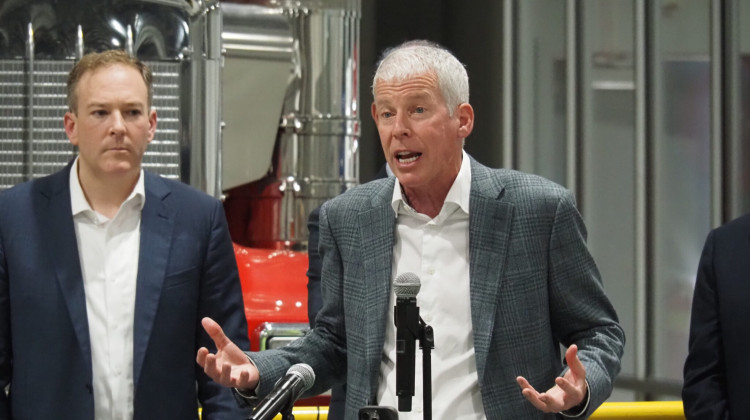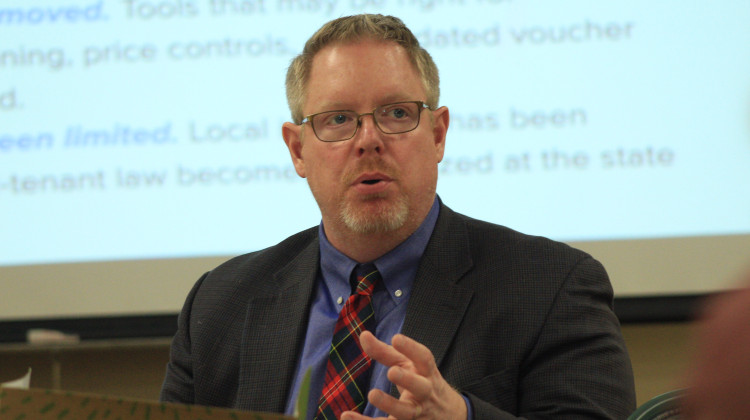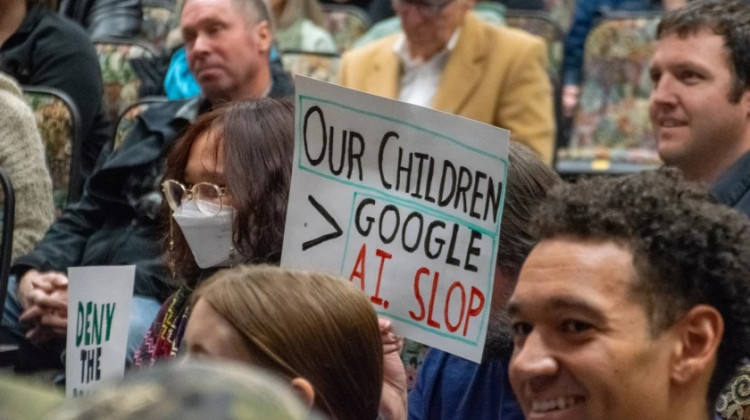
A sign telling pedestrians how to cross construction to access local businesses got some original artwork along West Lafayette's State Street.
Annie Ropeik/IPB NewsEconomic rebirth in Indiana downtowns can be a two-way street – literally.
Hoosier cities are spending millions to convert one-way main streets into two-way arteries.
The change can help boost the local economy, but it can also be hard on small businesses, like the one John von Erdmansdorff runs in West Lafayette.
Von Erdmansdorff is a local legend who’s spent almost 50 years selling all kinds of treasures out of his row of stores, Von’s Shops, on State Street.
It runs straight through Purdue University, meaning summer is usually a little slow – but nothing like this year, the year of State Street road construction.
“It’s awful when you go outside and you look in your parking lot [where] often, you’re worried about if there’s enough room for people, and there’s nobody out there but your employees,” von Erdmansdorff says.
Von’s Shops are boxed in as the city converts State Street from one- to two-way traffic. They’ve torn up pavement, fenced off most sidewalks, and restricted driving access for Von’s to an alley.
Von Erdmansdorff says it’s cut even their lower summer revenue in half, forcing him to lay off a third of his employees.
“We are going in the red every day,” he says. “We hope we can get through another seven weeks of this.”
West Lafayette broke ground on the $120 million State Street project right after graduation, and they’re racing to finish it by mid-August, when Purdue students return.
It’s an approach many Indiana downtowns take when modernizing their main streets. One of the latest to finish doing that is South Bend.
“If you do it all at once and have a lot of disruption but get it over with quickly, it’s like ripping off a Band-Aid,” says Pete Buttigieg, the city’s mayor. “You’re better off in the end.”
Buttigieg says South Bend did its best to communicate during construction. The city ran a website with live updates on detours, and kept in touch with business owners about their access needs.
The whole project cost $25 million. But Buttigieg says it’s helped bring in $90 million in downtown housing, hotel and retail investments.
“This is fundamentally not a traffic project – it’s an economic development project,” he says. “That’s what made it worth the investment; that’s what makes it worth accepting a couple minutes’ slowdown in your commute.”
West Lafayette development director Erik Carlson says there’s a simple reason to invest so much into making the switch.
“One-way streets make cities pass-throughs when they really should be destinations,” he says.
Standing on the corner of State Street – or what’s left of it – and Grant Street, which recently became two-way as part of the project, Carlson explains that the one-way pattern is a relic of suburbanization.
These days, he says, streets are about more than just moving cars quickly – they’re about bikes, people and commerce.
Carlson says West Lafayette’s narrower, two-way State Street will also have a lower speed limit.
“You want to stay there, you want to do business there – go buy something from a shop, have a drink on the sidewalk, enjoy your surroundings,” he says. “One-way streets don’t allow you to do that, by and large.”
But for now, State Street is not very welcoming. Noisy bulldozers kick up dust as they prepare the road for new pavement. The chain-link fences on the sidewalks bear signs with little dancing pedestrian figures, encouraging people looking for partially blocked stores to “keep going.”
Carlson says he knows it’s not an ideal way to do business.
“It looks like a mess right now – it’s a series of controlled chaos,” he says. “But it’s something that in the next few months, we know we’re going to have a real gem in the middle of West Lafayette, and we want people to come enjoy it and see why we’ve been doing all this work.”
Carlson attributes about $300 million in pending downtown investment at least in part to the State Street project. That means property values and taxes are going up in the area, too.
Back at Von’s Shops, John von Erdmansdorff says he’ll cross that bridge when he comes to it.
He’s more anxious for an actual bridge – the temporary one workers will build to his store in a couple weeks, after they pave the new State Street and start in on the sidewalks.
“I just keep hoping when the chain-link fence comes down, it’ll be more appealing for the pedestrian traffic,” he says. “And if the people out there listening know that they can still drive here, maybe they will come back too.”
After half a century on State Street, he hopes his business can endure just a little longer.
 DONATE
DONATE








 Support WFYI. We can't do it without you.
Support WFYI. We can't do it without you.